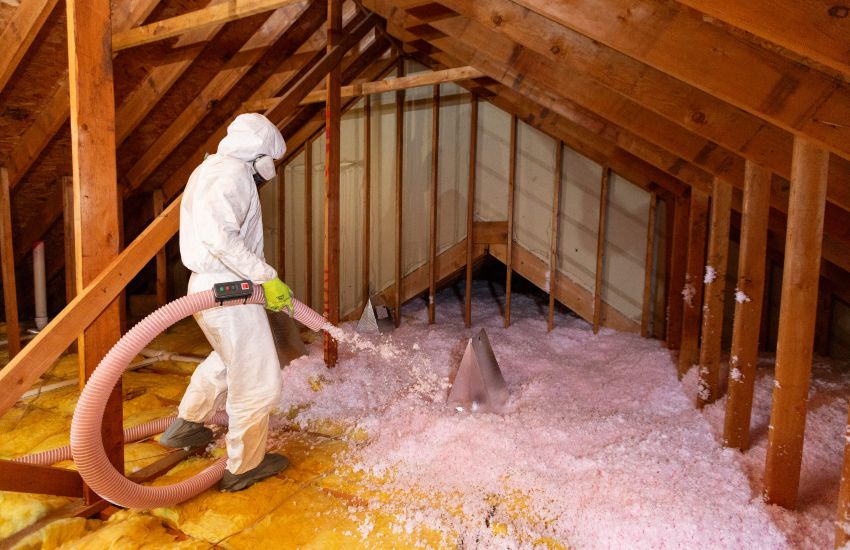
If you’ve ever shivered your way through the winter or sweated out the summer, even as your energy bills skyrocketed, you could be short on insulation. While your entire home needs insulation—from the foundation to the walls to the ceilings—attic insulation is particularly crucial. Many styles and materials are available, but blown-in fiberglass, cellulose, and mineral wool make especially effective attic insulation.
Yet, smothering the attic floor with insulation isn’t the ultimate fix. There is such a thing as over-insulating, which is when the insulation covers the holes meant to provide ventilation. After all, you want your home’s ceiling to be properly sealed and insulated, but the attic still needs to breathe. This is accomplished by keeping attic vents uncovered. You can even install an attic fan to mechanically pull air into and out of the space.
If it’s been a while since you thought about what’s happening in your attic, it could be time to add ProCat Professional Loose Fill Insulation by Owens Corning and verify proper roof ventilation. Here’s how you’ll benefit when you prioritize both improvements.
Benefits of Blown-in Insulation
Energy Efficiency
Blown-in insulation is highly effective at maintaining a balanced indoor climate, keeping your attic cooler in the summer and warmer in the winter. Its ability to fill the smallest cracks and crevices helps your HVAC system operate at peak performance. As a result, your indoor comfort improves even as your energy consumption goes down.
Fire Safety
Materials like cellulose, fiberglass, and mineral wool contribute to fire safety because they are treated with flame-retardant chemicals. If they ever catch fire, the flames will spread slowly so firefighters have more time to douse the blaze before widespread damage occurs.
Quick and Easy Installation
Installation is a breeze when you opt for blown-in insulation. If you do it yourself, you’ll need to rent an insulation blower to deliver the insulating material where needed. Otherwise, hire a professional to do the job for you.
Great for Older Homes
All newer properties are built to code, but some older homes have odd nooks and crannies, making standard insulation batts difficult to install. Blown-in insulation has no trouble filling in floor joists spaced any distance apart. It fills unusual gaps and covers hard-to-reach areas, forming an even, insulating layer. You can even blow the material over ductwork that runs through the attic.
Able to be Installed Over Batting
You can install blown-in insulation over existing batts. Doing so enhances the R-value and thermal performance of your attic insulation. Just make sure your existing fiberglass batts are in good condition and that the materials are compatible. Check the depth of your existing batts and add enough blown-in insulation to meet or exceed the recommended R-value for Delaware’s climate.
Wise Investment
Adding blown-in insulation to your attic is a financially savvy home improvement project. The energy cost savings help the installation pay for itself, providing a return on investment that really adds up over the years.
The Importance of Roof Ventilation
Optimized Airflow
While insulation is essential for temperature control, proper attic ventilation is also crucial. Leave the soffit vents uncovered to draw in fresh air from under the roof’s eaves. The air then drifts toward the baffle, gable, or ridge vents, circulating throughout the attic in the process.
Attic vents churn out stale attic air and maintain a relatively comfortable temperature. This controlled airflow is crucial to prevent condensation, a major cause of mold growth.
Moisture Management
A sealed, insulated attic floor is your first line of defense against humidity because it prevents daily activities like bathing, cooking, or laundry from contributing to attic moisture. Of course, you need a well-designed roof ventilation system to complement the attic insulation. A constant influx of fresh air is the key to preventing moisture buildup.
Optimizing Insulation and Ventilation
While insulation and ventilation are two separate components, they function best when working in tandem to regulate your attic’s climate. Here are some practical tips to enhance attic insulation without undermining ventilation:
- Install soffit vents and pair them with other ventilation methods like ridge, baffle, or gable vents.
- Regularly inspect and clean the attic vents to ensure unobstructed airflow.
- Consider installing an attic fan.
- Schedule a professional attic inspection to identify areas needing air sealing or additional insulation.
Take the Next Step with Ferris Home Improvements
By focusing on both attic insulation and roof ventilation, you’ll create a safe, energy-efficient environment above your living space. If you’re ready to elevate your home’s comfort and efficiency with ProCat Professional Loose Fill Insulation by Owens Corning, turn to Ferris Home Improvements. We are a local, family-owned and operated home improvement company that has served Delaware since 2004. Our team boasts over 40 years of experience and has a reputation for offering top-notch services and craftsmanship. We proudly complete hundreds of jobs each year and love being involved in the community. Call us at 302-998-4500 today for help meeting all your insulation and ventilation needs.
